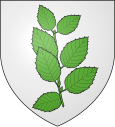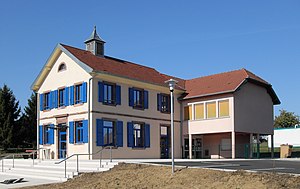Charmois (Territoire de Belfort)
| Charmois | ||
|---|---|---|

|
|
|
| region | Bourgogne-Franche-Comté | |
| Department | Territoire de Belfort | |
| Arrondissement | Belfort | |
| Canton | Châtenois-les-Forges | |
| Community association | Grand Belfort | |
| Coordinates | 47 ° 34 ' N , 6 ° 56' E | |
| height | 330–371 m | |
| surface | 4.17 km 2 | |
| Residents | 340 (January 1, 2017) | |
| Population density | 82 inhabitants / km 2 | |
| Post Code | 90140 | |
| INSEE code | 90021 | |
 Town hall and school building |
||
Charmois (German earlier Zarmwiller ) is a commune in the department Territoire de Belfort in the region Bourgogne Franche-Comté .
geography
Charmois lies at 334 m above sea level, about nine kilometers southeast of the city of Belfort (as the crow flies). The village extends in the plains of the Burgundian Gate , on the northern edge of the wide valley plain of the Bourbeuse , in which the waterway of the Rhine-Rhône Canal is also located, opposite Froidefontaine, between the plateaus of Les Grands Bois in the north-west and Bois Lachat in the Southeast.
The area of the 4.17 km² municipal area covers a section of the landscape in the area of the Burgundian Gate (Trouée de Belfort) with only weak relief. The southern border always runs along the Bourbeuse, which meanders through a wide valley floor and provides drainage to the Allaine . From the Bourbeuse, the community area extends north over the valley floodplain and a gently rising slope, which is subdivided by several short side streams, to the adjacent plateau. This is an average of 360 m and is partly covered with arable land and meadow, partly with forest. In the far north is the Les Grands Bois forest area , where the Charmois peak is reached at 371 m. The eastern border forms with the Praille a right tributary of the Bourbeuse.
Charmois neighbors are Meroux and Novillard in the north, Autrechêne in the east, Froidefontaine in the south and Bourogne in the west.
history
Charmois was first mentioned in writing in 1105 in a document from the Froidefontaine priory. The place name goes back to the French word charme ( white beech ). In the middle of the 14th century the village came under the sovereignty of the Habsburgs. Together with the Sundgau , Charmois came to the French crown with the Peace of Westphalia in 1648. Since 1793 the village has belonged to the Haut-Rhin department , but in 1871 it remained as part of the Territoire de Belfort, unlike the rest of Alsace, in France. Since 2005 Charmois was initially part of the Communauté d'Agglomération Belfortaine , which was merged into the Communauté d'agglomération Grand Belfort in 2017 .
population
| Population development | |
|---|---|
| year | Residents |
| 1962 | 116 |
| 1968 | 121 |
| 1975 | 115 |
| 1982 | 203 |
| 1990 | 227 |
| 1999 | 261 |
With 340 inhabitants (January 1, 2017) Charmois is one of the small communes of the Territoire de Belfort department. After the population decreased in the first half of the 20th century (196 people were still counted in 1896), the population has continued to grow steadily since the mid-1970s.
Economy and Infrastructure
Until well into the 20th century, Charmois was mainly a village characterized by agriculture (arable farming, fruit growing and cattle breeding) and forestry. In addition, there are now some local small businesses. In the meantime the village has turned into a residential community. Many workers are therefore commuters who work in the larger towns in the area and in the agglomerations of Belfort and Montbéliard .
The village is off the main road connections on a departmental road that leads from Danjoutin to Froidefontaine. The closest connection to the A36 motorway is around nine kilometers away. There are other road connections with Bourogne and Autrechêne.
literature
- Le Patrimoine des Communes du Territoire de Belfort. Flohic Editions, Paris 1999, ISBN 2-84234-037-X , pp. 112-113.
Web links
Individual evidence
- ^ Topographical dictionary of Upper Alsace: containing the old and new place names on behalf of the industrial society of Mulhouse, published by Georg Stoffel; 1876
